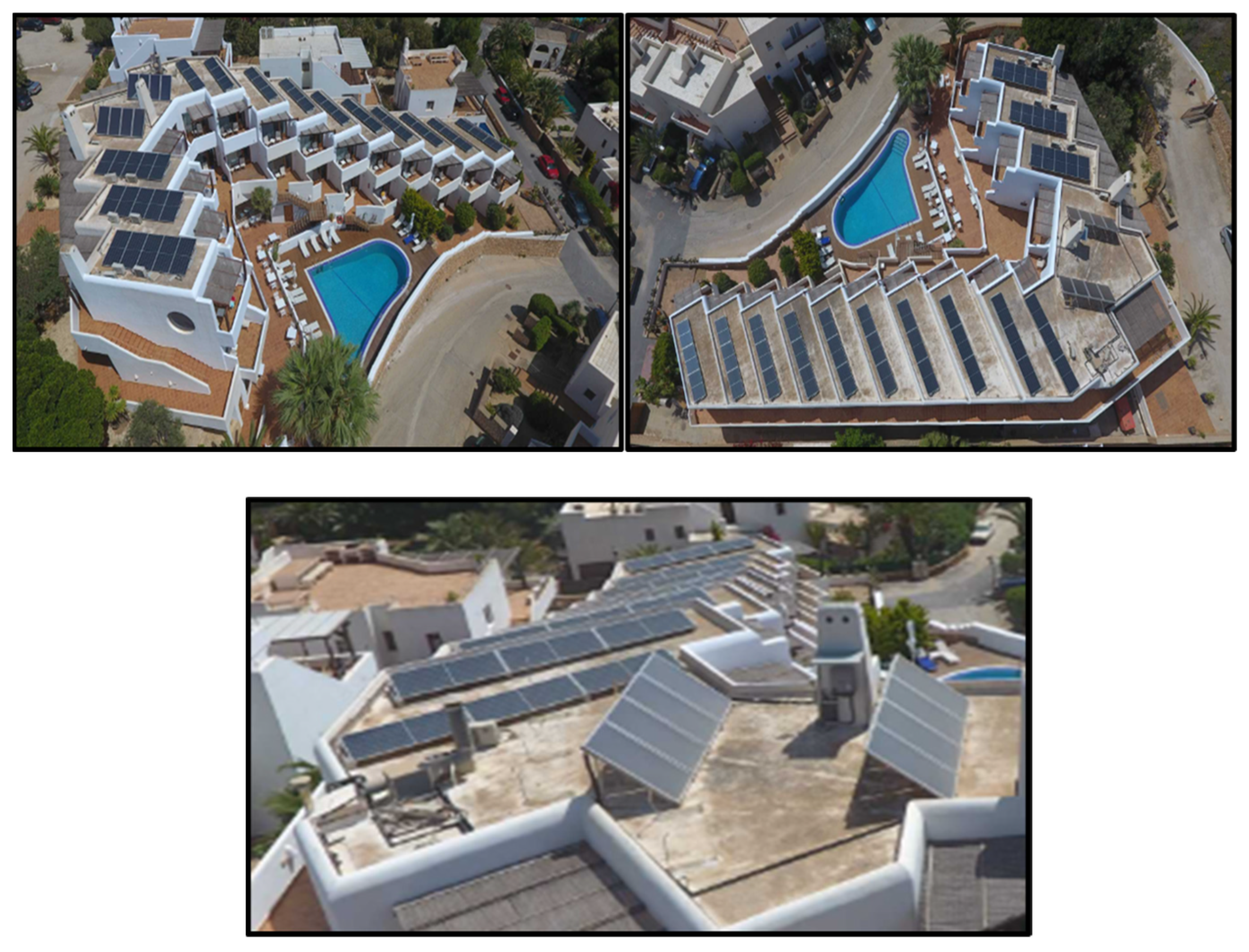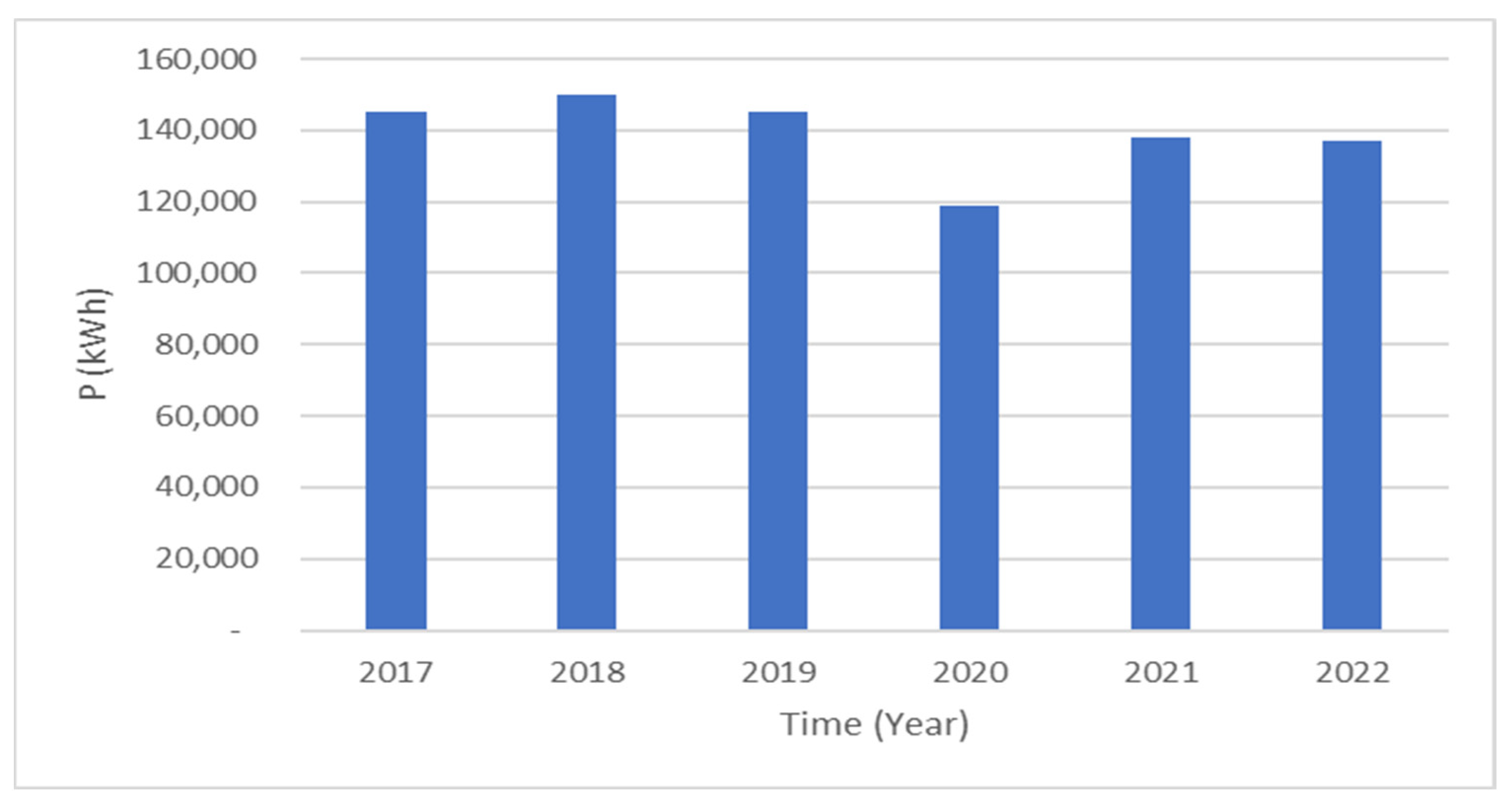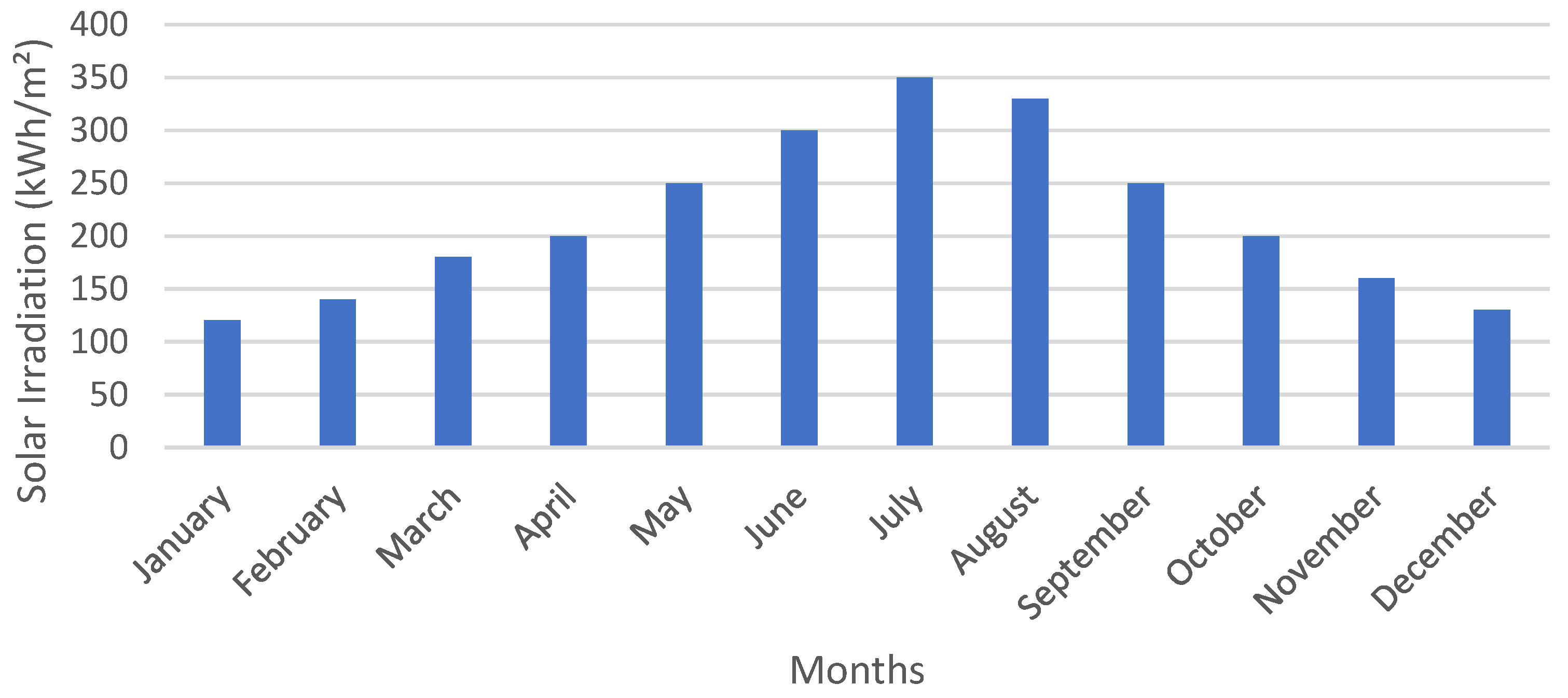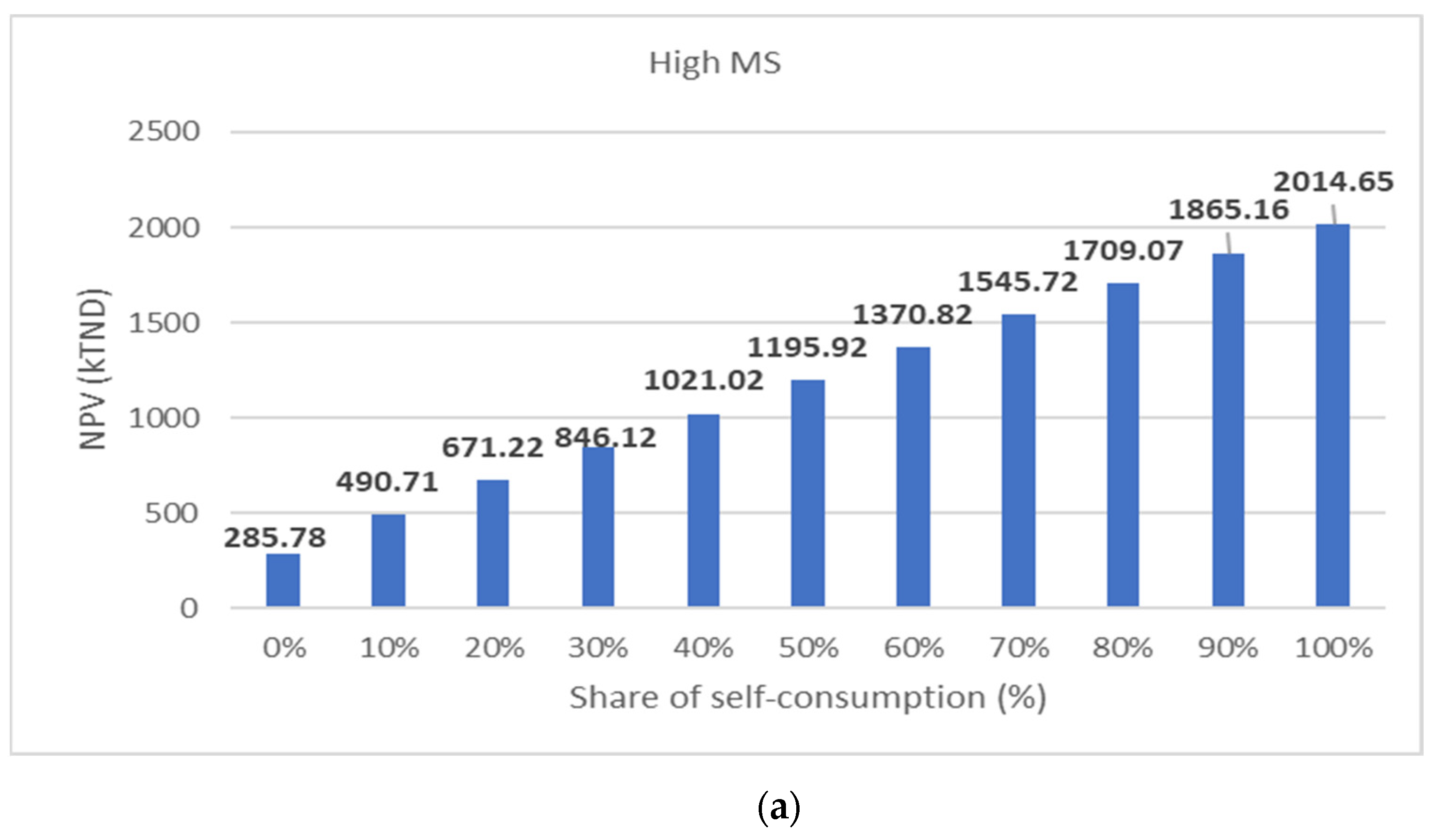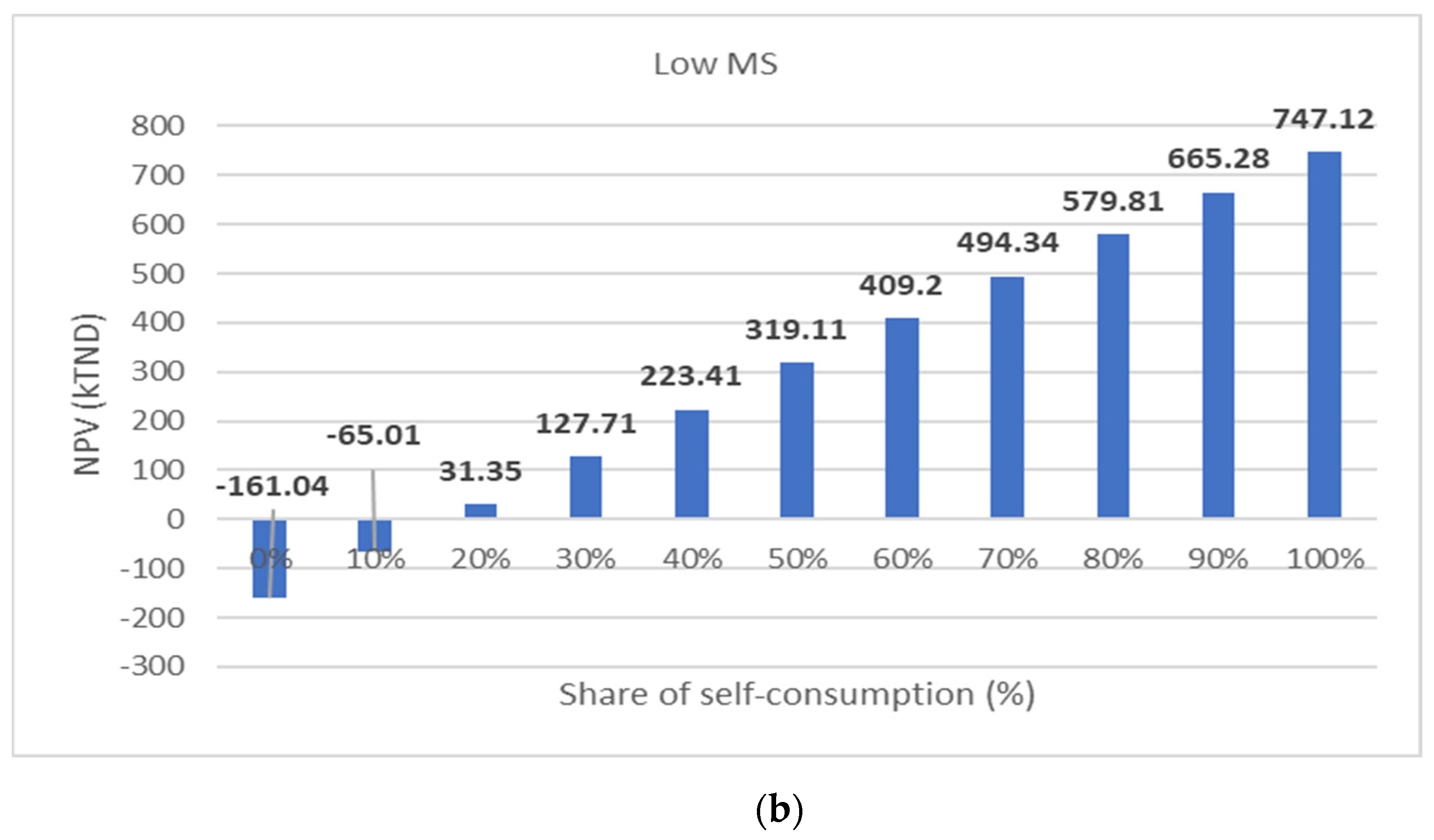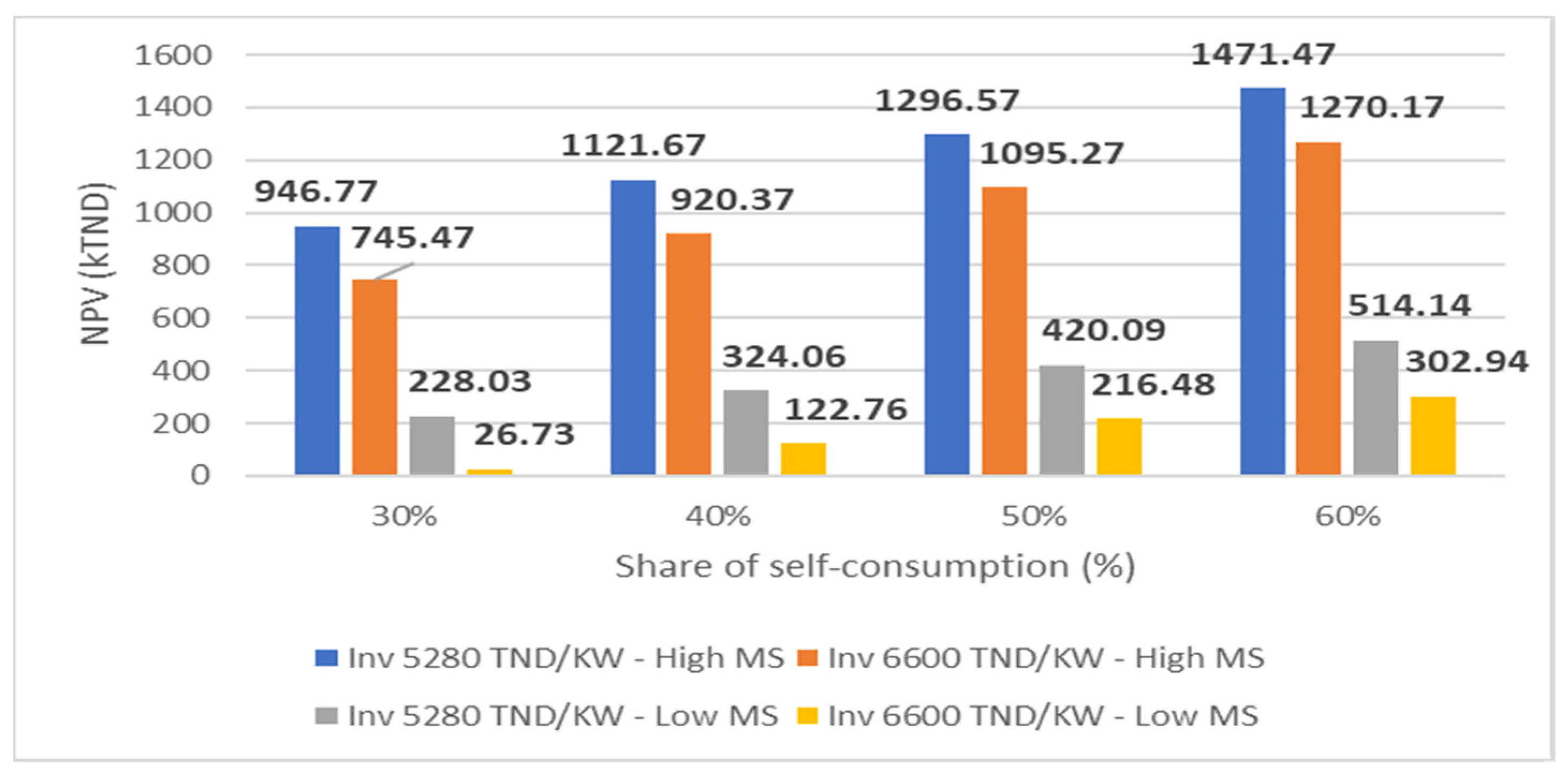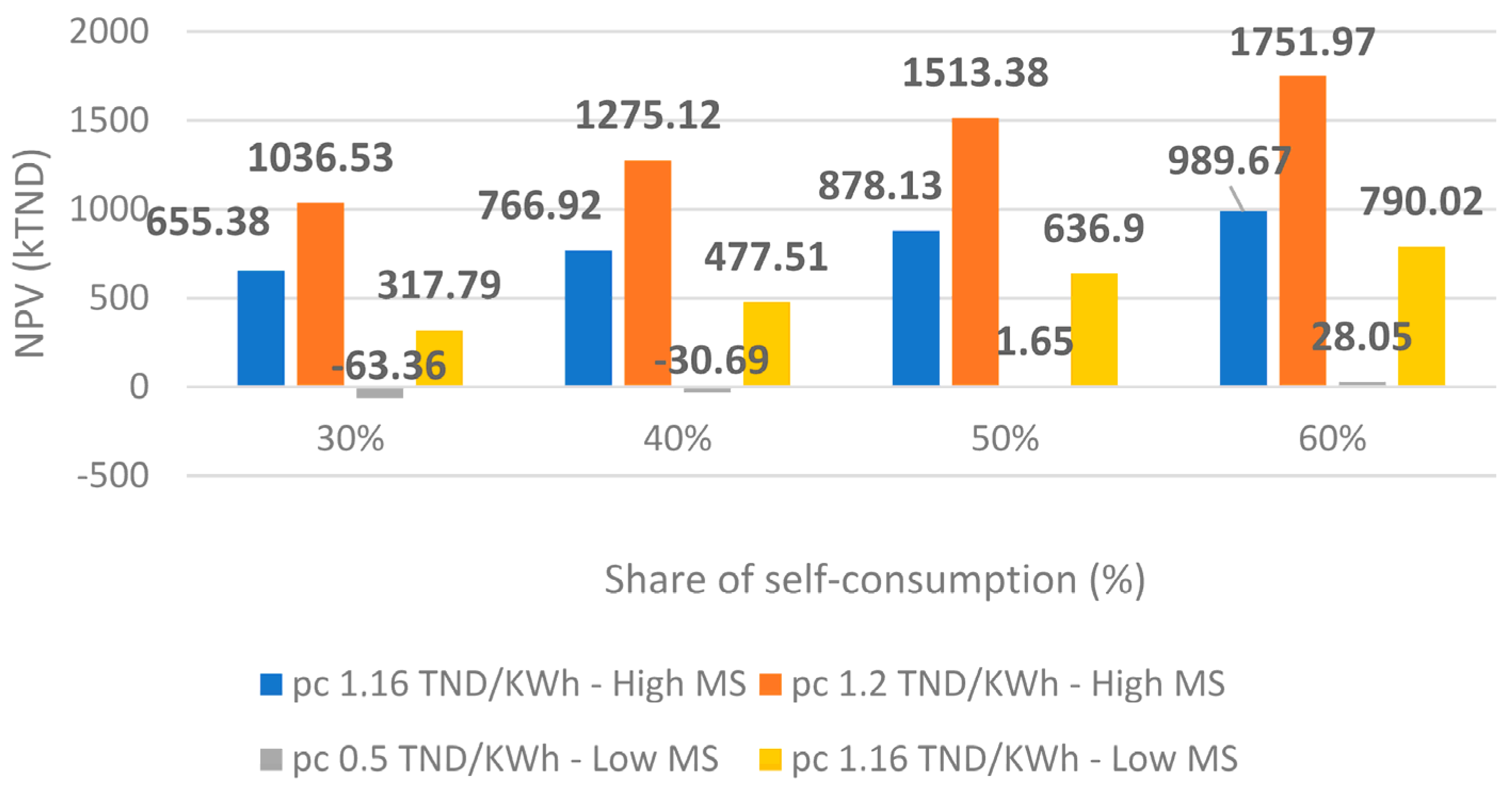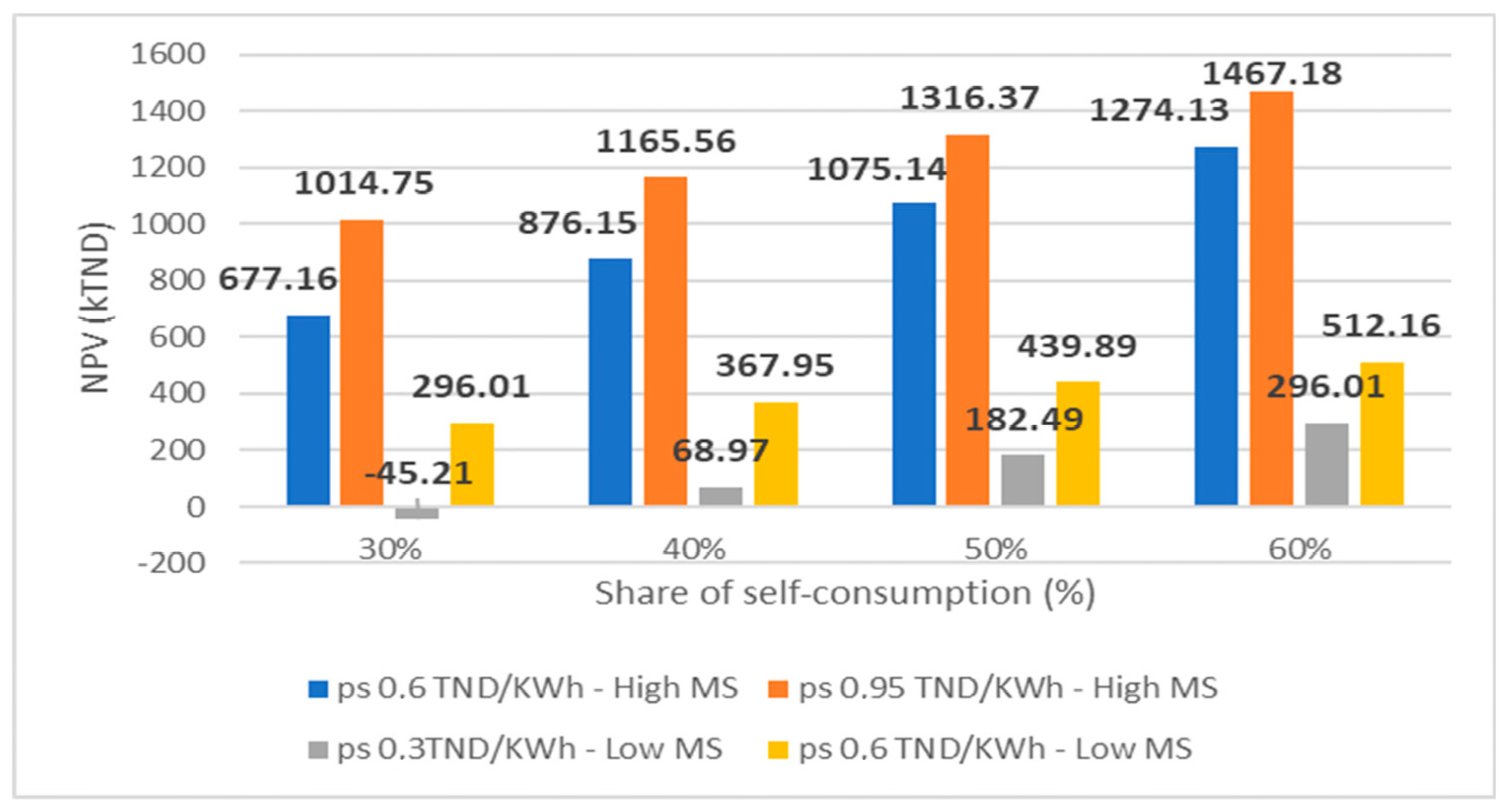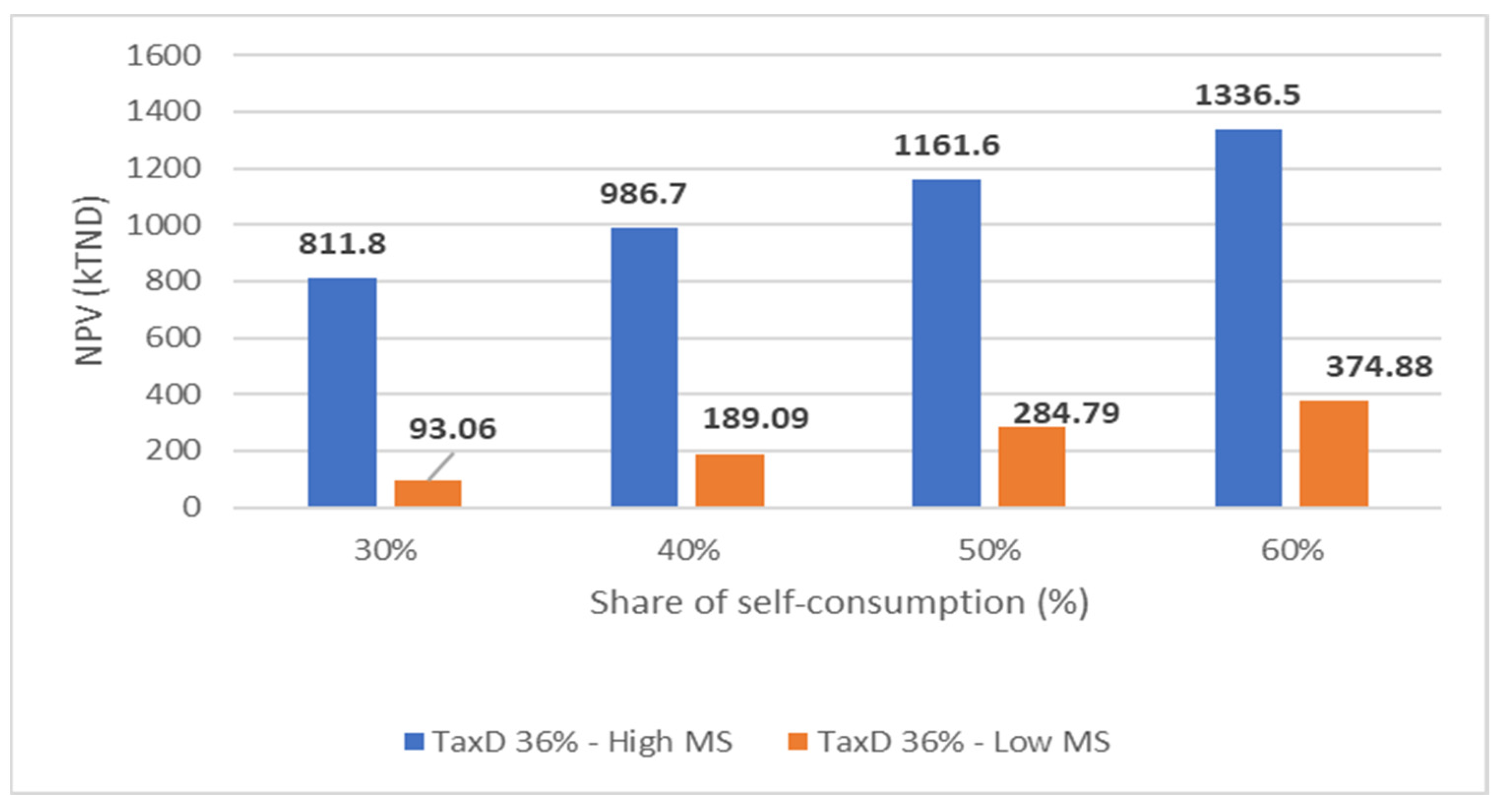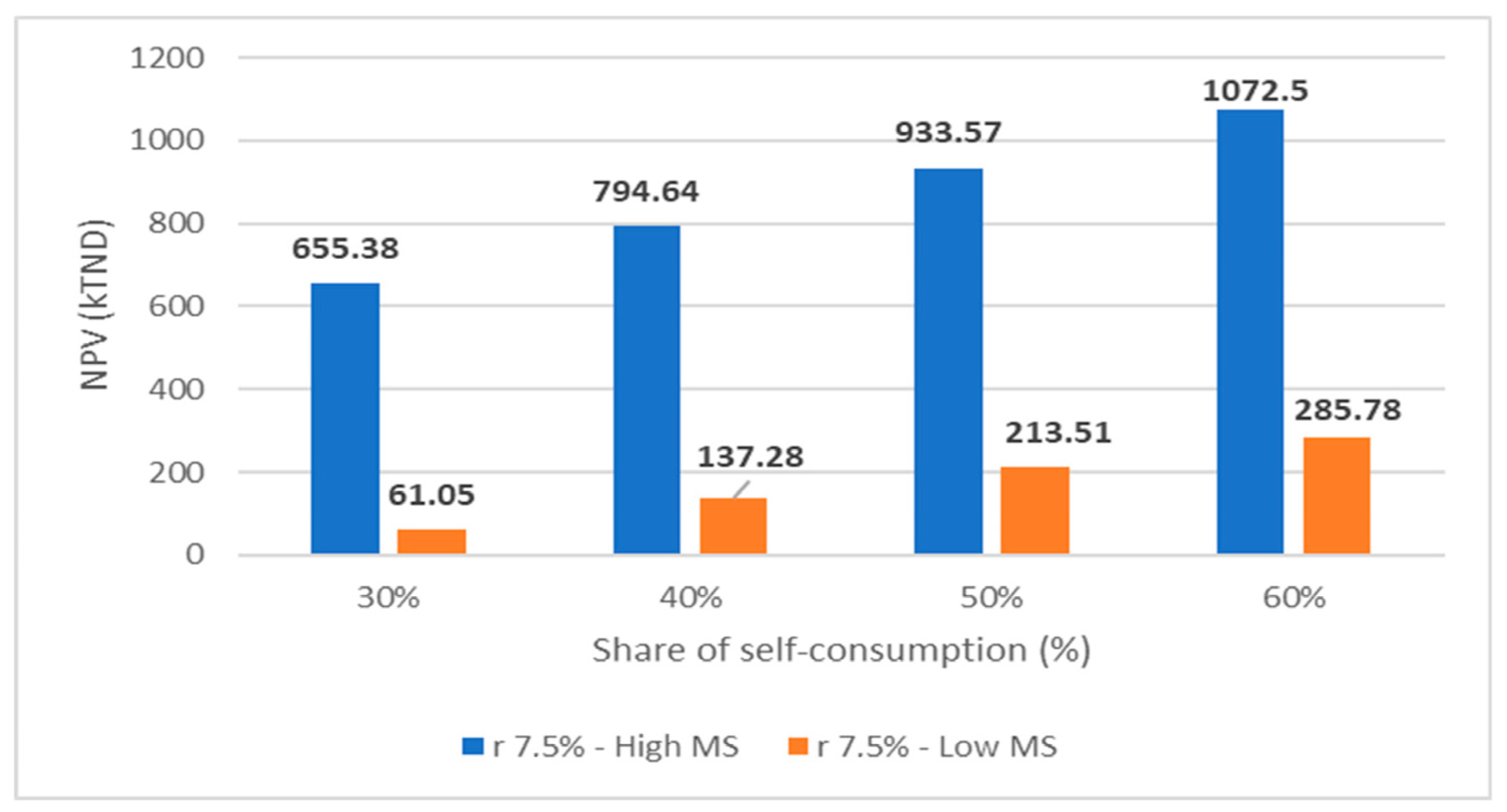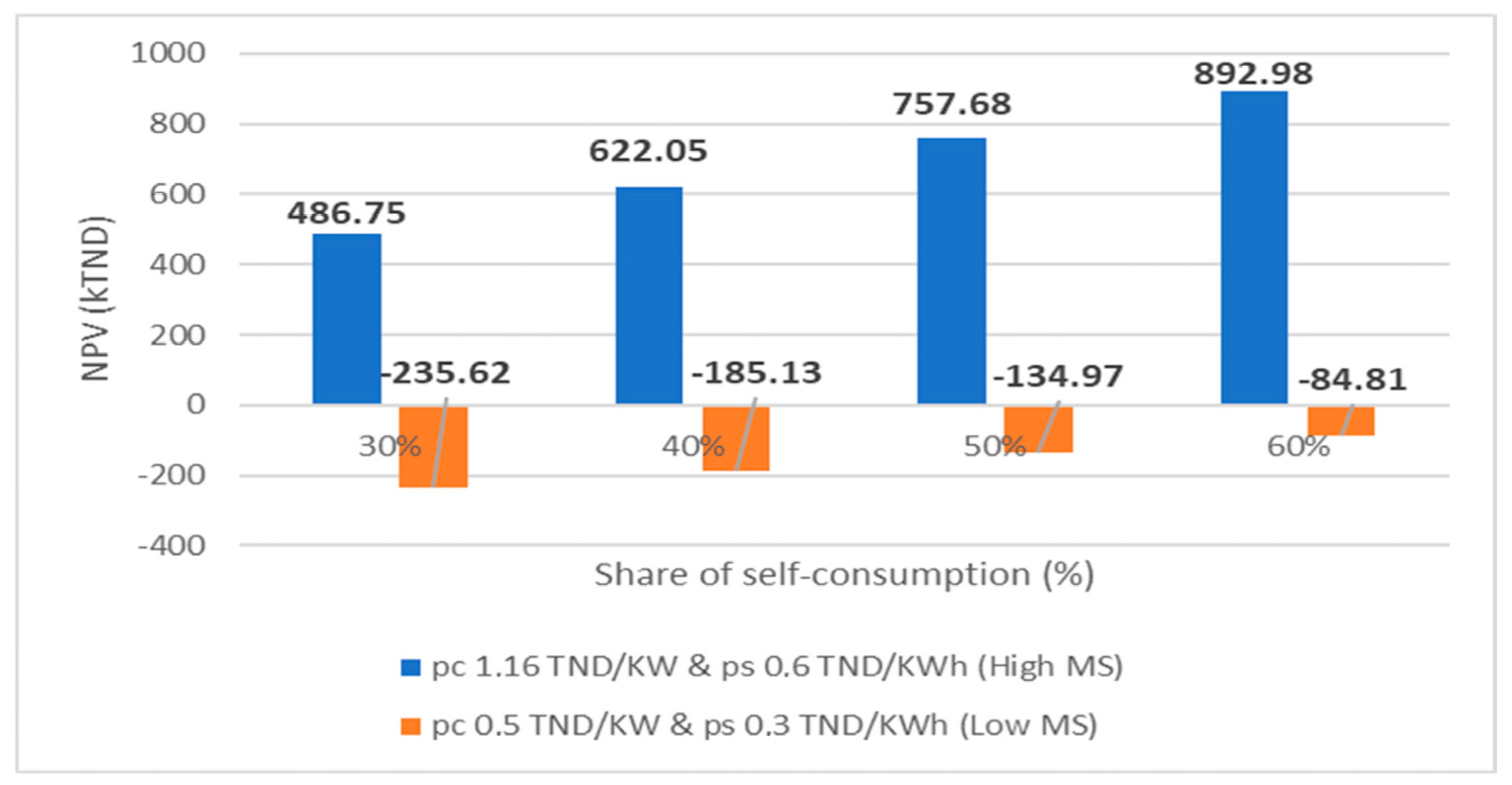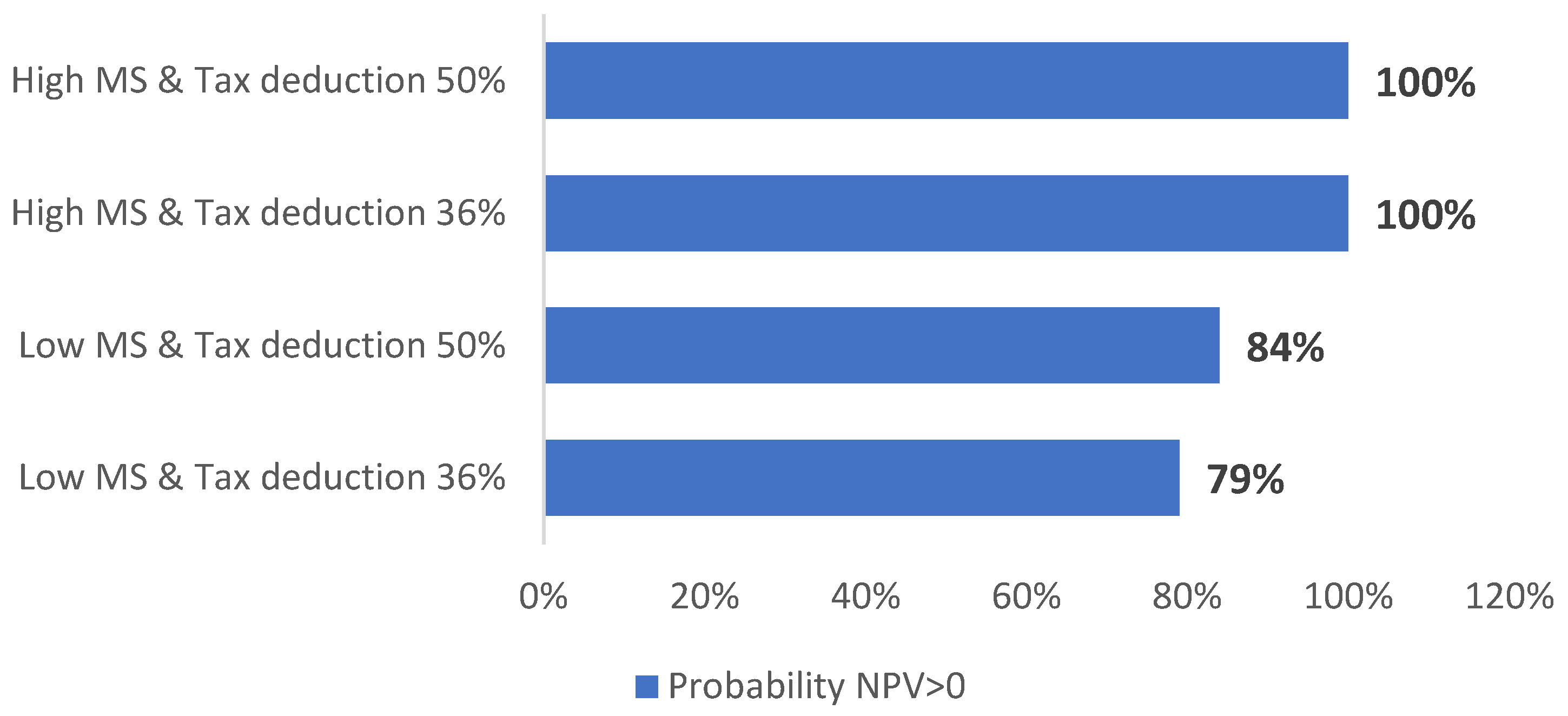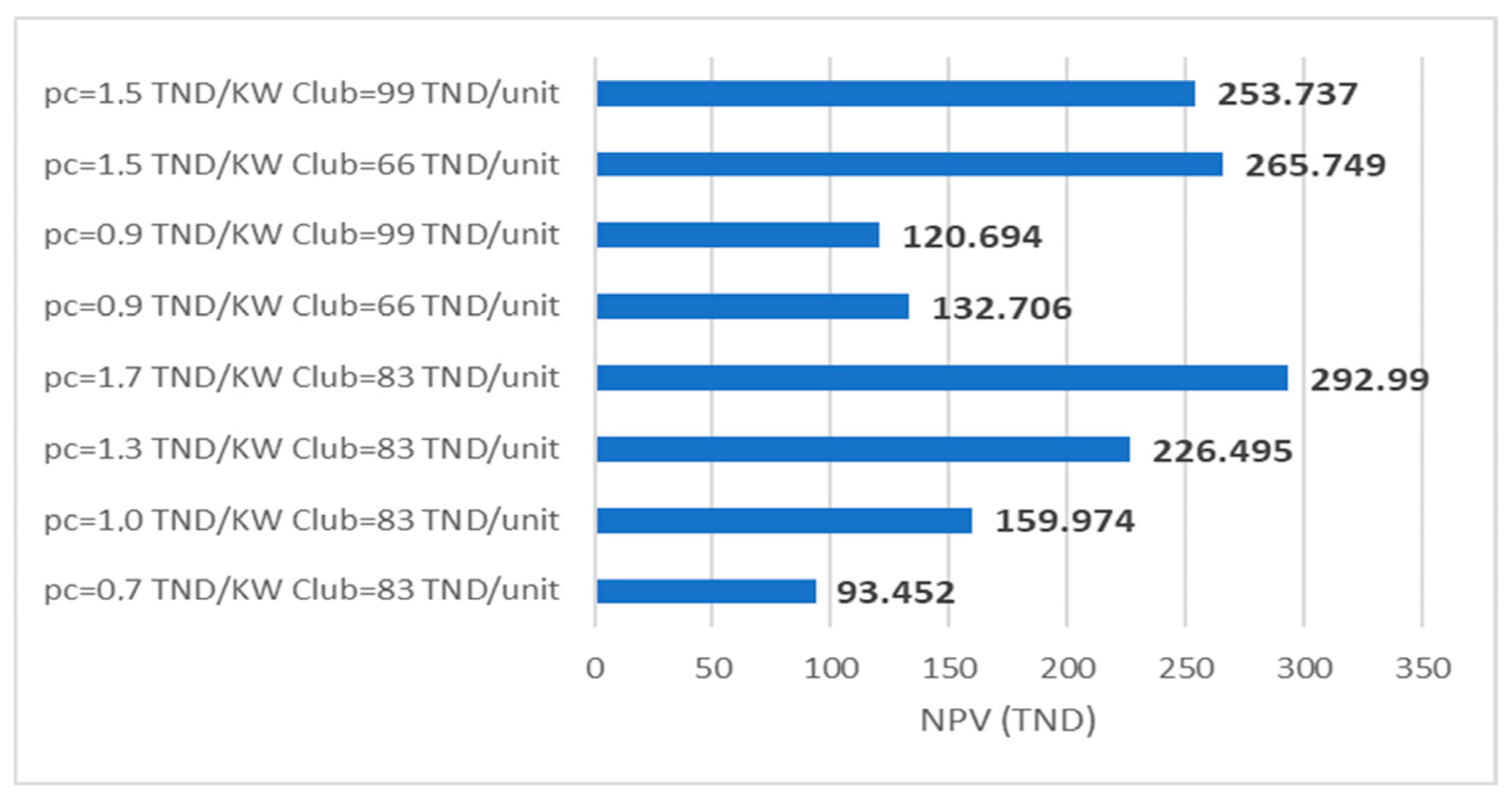1. Introduction
The mission of policymakers is fundamental in the shift to sustainable energy to achieve a society with reduced carbon emissions. Increased knowledge and product variety expansion can contribute to reducing the consumption of environmental resources [
1]. Ecological taxes incentivize the consumption of renewable energy while affecting carbon emissions and indicate that the provision of subsidies promotes increased investment in this sector [
2,
3]. Political regulations granted in this context are essential [
4]. Renewable energy supports economic growth more than non-renewable energy while mitigating problems of environmental degradation [
5,
6,
7]. At that moment, energy optimization practices have a key function in economic development [
8]. Several studies show that renewable energy can reduce volatility in energy markets, allowing consumers to experience fewer fluctuations in energy prices and also the speculative phenomena associated with them [
9,
10].
Renewable energy brings benefits in terms of energy security and economic growth [
11,
12]. To promote their development, we must act on several fronts: we must integrate education into ecological practices [
13] and energy efficiency from school curricula [
14], focus on meeting demand, which will be crucial for future electricity networks, and act on electricity prices, which is identified as the most important lever to reduce total energy consumption [
15,
16].
The tourism sector is also affected by these developments and can benefit from sustainable management of natural resources [
17,
18] as well as circular strategies. Among the major challenges for the hospitality sector are waste of food energy and water usage, where sustainable economic approaches can play a crucial role in fostering sustainable and economic development [
19,
20]. The hospitality industry is actively participating in this paradigm shift [
21], requiring a multi-stakeholder approach. In particular, green practices in hotels can clearly help achieve several sustainable development goals [
22,
23].
Sustainability as a topic is particularly pertinent to the tourism sector [
24,
25], especially regarding energy savings, which is a major concern for the hospitality industry. A hotel energy solution that reduces their consumption brings economic benefits to the hotel [
26,
27,
28]. It also makes the hotel more environmentally friendly. By saving energy, you can help protect the environment by reducing the resources needed to produce electricity, such as FF. This reduces carbon emissions [
29,
30]. The hospitality industry consumes a prodigious amount of energy. In addition to lighting and heating, electricity is used to power kitchen appliances, computer systems, gym equipment, heated swimming pools, electronic doors, etc. The main resources used to produce electricity are FF: coal, oil, natural gas, etc. These energies are not renewable; they require special transformations that lead to greenhouse gas emissions. The exploitation of these energies thus promotes the high-speed acceleration of global warming [
25].
Due to the over-consumption of electricity in hotels, there is an urgent need to adopt renewable energy technologies such as solar energy. Solar panels made of photoelectric cells have become much more efficient in recent years. Hotels can install solar panels on their premises to generate electricity or look for energy suppliers that get their electricity from solar farms. In this case, you can reduce energy bills and impress guests by installing solar panels in hotels. In some areas, you may be able to apply for a grant or low-interest loan to cover the cost of switching to solar energy. If you live in an area that gets a lot of sun, you may even end up with excess energy to sell back to the grid. In addition to providing your hotel with an immediate source of electricity for a relatively low outlay, solar panels provide visual assurance that your business is committed to sustainability [
31].
Most hotels attract guests because of their location. If your hotel is in a scenic area where people come to admire the natural beauty, you want to make sure you protect that environment. Even if your hotel is not, guests are often willing to pay more for a more sustainable stay [
32,
33,
34]. Implementing green energy solutions in hotels is one way to ensure that your hotel’s environmental impact is minimized. This attracts guests and can also help secure staff who want to work for a more environmentally conscious company. In this case, using eco-friendly solar lighting solutions can help reduce the negative impacts of lighting on the environment [
35,
36,
37,
38].
Solar lighting helps reduce dependence on non-renewable energy sources as it uses solar energy, which is a free renewable energy source, and also reduces electricity costs. By replacing your current lighting systems with modern LED lighting, which has very encouraging potential, you can reduce your consumption [
39,
40,
41]. LED lighting is very flexible and comes in different tones, allowing you to create the perfect ambiance in every part of the hotel. In addition to reducing bills, smart LED lighting in your rooms allows guests to choose the level and color they prefer. If you are still using incandescent lighting or older energy-saving bulbs, it is time to move on to a better future [
42,
43,
44].
Companies, especially hotels, need therefore to re-examine their current technologies in order to develop innovative solutions that promote green competitiveness and meet emerging environmental requirements [
24]. Previous studies have examined the integration of renewable facilities, highlighting economic benefits [
26,
27].
The combination of photovoltaic systems and LED lighting is an ideal solution for hotels looking to optimize their energy use. Solar energy can power energy-efficient LED lighting systems, further amplifying the environmental and economic benefits. This combination also helps hotels achieve sustainability certifications such as Leadership in Energy and Environmental Design or Green Key [
28,
29,
30,
45].
In this regard, photovoltaic systems and LED bulbs have emerged as significant solutions for hotels aiming to reduce energy consumption and carbon footprints.
Photovoltaic systems, which convert sunlight into electricity, have gained considerable attention in the hospitality industry due to their potential for reducing energy bills and reliance on fossil fuels.
The integration of photovoltaic systems and LED lighting in hotels has emerged as a significant trend aimed at enhancing energy efficiency and sustainability in the hospitality industry. Recent studies in 2024 have highlighted the benefits of these technologies, demonstrating how they can transform hotel operations.
This transformation begins with the adoption of photovoltaic systems, which not only provide energy independence but also enhance a hotel’s brand image through a commitment to sustainability. By harnessing solar energy, hotels can meet up to 40% of their energy demands, particularly in sunny regions, thereby reducing reliance on traditional energy sources [
31]. With advancements in solar technology, such as high-efficiency panels and solar tracking systems, further optimize energy production and make these systems more viable for various hotel sizes [
39]. The following study has emphasized the role of solar tracking systems, which adjust the orientation of photovoltaic panels to optimize energy production based on the position of the sun. Research in a hotel located in a tropical climate demonstrated that such systems could increase the overall energy output by 30% compared to fixed panel systems [
40]. Other research has proven that hotels increasingly turn to photovoltaic systems; they also benefit from improved financial viability. Although initial installation costs can be significant, the long-term return on investment is favorable, with payback periods ranging from 5 to 7 years. This financial incentive is complemented by government incentives and tax rebates that make solar energy solutions even more attractive [
46]. Transitioning to LED lighting represents another critical innovation in hotel energy management. The shift from incandescent and fluorescent bulbs to LEDs has resulted in substantial energy savings, with LEDs consuming 75% less energy and lasting significantly longer than traditional options. This transition not only reduces electricity consumption by up to 30% but also enhances the guest experience through better lighting quality [
47]. Moreover, subsequent study has shown that the incorporation of smart LED lighting systems allows for further optimization of energy use. By integrating motion sensors and automated dimming capabilities, hotels can achieve additional savings of up to 40% on lighting costs, ensuring that energy is used efficiently based on occupancy levels [
48]. Studies that appeared after have improved the quality of light, making LEDs a viable replacement for both aesthetic and functional lighting in hotels, which offers better color rendering indices and can be customized to create different lighting atmospheres, a key consideration for the hospitality industry [
49]. A recent study deals with the synergy between photovoltaics systems and LED lighting technologies that allows for the creation of a powerful combination that can drastically improve a hotel’s overall energy efficiency. This study has shown that integrating these technologies can lead to reductions in total energy consumption by as much as 60%, with photovoltaics supplying necessary power for various applications, including lighting, heating, and cooling [
50]. To maximize these benefits, a study of the implementation of energy management systems has been carried out in the literature. These systems monitor and control energy usage effectively, ensuring that the energy generated by photovoltaics systems is utilized efficiently while dynamically adjusting lighting based on real-time occupancy data. This holistic approach not only enhances operational efficiency but also reinforces the hotel’s commitment to sustainability [
51]. The adoption of photovoltaics systems alongside advanced LED lighting technologies represents a transformative shift in the hospitality sector towards greater sustainability, efficiency, and cost-effectiveness. By embracing these innovations, hotels can significantly reduce their carbon footprint while appealing to environmentally conscious guests, ultimately leading to enhanced brand loyalty and market competitiveness.
The literature has explored the Tunisian case, highlighting the dynamic function of consumers as a key element in establishing a novel societal system focused on the production and personal use of sustainable energy [
41,
52,
53]. Sustainable technologies, including photovoltaic (PV) panels and LED lamps, have been praised for their ability to strengthen the financial and operational performance of institutions [
32,
35]. Consequently, sustainability concerns within the hotel industry are now essential for the various involved parties concerned [
33]. This study intends to sustain this line of research, since hotels, by meeting the challenges of competitiveness and tackling the urgency of fighting global warming, can determine innovative ecological solutions. This study analyzes the combination of two types of technologies (photovoltaic systems and LED bulbs) with the aim of facilitating the transition of hotels to green projects. For this purpose, an evaluation of sustainable practices was carried out, including economic, ecological, and social aspects, to assess the advantages of adopting renewable energy sources and energy optimization in a hotel in the Tunisian framework.
A theoretical and a numerical study will be carried out in this framework. These studies play a major role in energy transition projects due to their economic, environmental, technical, and technological contributions, which proves the importance of the multidisciplinary approach to address the energy transition holistically in the Tunisian hotel sector.
2. Methods
The application of sustainable development in hotels focuses on integrating practices that reduce environmental impact while promoting social and economic well-being. This approach is essential to address the world’s most pressing challenges, including poverty, inequality, climate change, environmental degradation, peace, and justice.
Each of the sustainable development goals has specific targets and indicators designed to measure progress. Achieving these goals requires a collaborative effort from governments, businesses, hotels, and individuals, all of whom play a vital role in implementing sustainable practices. The interconnected nature of the sustainable development goals means that progress in one area can positively influence others.
The aim of this study is to develop an integrated approach that considers environmental, social, and economic aspects, ultimately providing a tourism experience that is enjoyable, environmentally friendly, and beneficial for local communities. By aligning hotel operations with the sustainable development goals, who can contribute to a sustainable future while enhancing their appeal to environmentally conscious travelers.
The approach section outlines the economic aspects in
Section 2.1 and the environmental considerations in
Section 2.2 considered for the purpose of examining the photovoltaic system. Subsequently,
Section 2.3 introduces the data on the energy efficiency of LED bulbs, which is succeeded by an examination of the social aspect in
Section 2.4. The methods employed in this research incorporated a combination of quantitative methodologies, encompassing discounted cash flow and determination of reductions in emissions of carbon dioxide and energy consumption, as well as an online questionnaire, with the goal of offering an in-depth assessment of sustainability.
Figure 1 presents the installation and the arrangement of the PV panels in the roof hotel.
2.1. Economic Data and Photovoltaic Modules
Solar energy systems (manufactured in Marseille, France) offer substantial potential for their installations in Tunisia [
34]. The political context has a significant influence in determining these trends. A discounted cash flow was used to analyze the profitability of the project, considering the passage of time and the diverse cash flows throughout the life of the project. This approach is really recognized in the existing literature to analyze sustainability initiatives while providing strategic insights to key stakeholders [
36,
41].
Several measures have been suggested to evaluate the profitability of a project: the net present value: it represents the value generated by a project; the internal rate of return: it indicates the rate of economic return associated with a project; the cost of doing nothing discounted over one year: this measure evaluates the economic value forfeited by postponing the project for one year; and the discounted return on investment: it determines the time required to recover the capital initially invested [
37].
The cash flows of a photovoltaic system include savings on the electricity bill, which is a benefit for the consumer; income generated from the sale of energy produced and not used in self-consumption; and investment costs that are significantly higher than the operating costs of the inverter, which will have to be replaced after a period of ten years. The suggested economic system aligns with the structure described in Equations (1)–(5) [
28,
37].
The net present value (NPV [TND]) can be calculated as Equations (1) and (2).
where DCI [TND] is the discounted cash inflow and DCO [TND] is the discounted cash outflow.
The discounted do nothing cost 1 year (DDNC-1 [TND]) can be calculated as Equation (5).
where DPBT [Years] is the discounted payback time, N [Years] is the lifetime of the project and r [TND] is the opportunity cost of capital.
Table 1 displays the economic information utilized in this study.
Considering the evolving energy environment, marked by considerable fluctuations in energy costs, two market scenarios (MS) were considered:
Figure 2 shows the energy consumption. During the first year, the generated energy was estimated at 145,000 kWh, using PVGIS software. The installation of a photovoltaic panel would attain an energy self-use rate of 50% of the energy produced.
2.2. Environmental Data and Photovoltaic Systems
Photovoltaic systems are emerging among the multitude of technologies as attractive solutions for sustainable and clean energy production [
29,
30,
38]. This analysis of the environmental impact of the photovoltaic system is based on the idea that one kilowatt hour of energy generated from renewable energy sources can substitute one kilowatt hour of energy derived from fossil fuels, which would lead to a reduction in CO2eq emissions [
45]. New methods have been developed in the literature to optimize the environmental performance of these systems [
37,
38].
The RECD was quantified by replacing the energy mix (excluding renewable energies) with that generated by a photovoltaic system.
The suggested energy model aligns with the structure described in Equations (6) and (7).
The reducing carbon dioxide emission (RECD [gCO2eq/kWh]) can be calculated as Equation (6).
The carbon dioxide emission of fossil fuels (ECD
FF [gCO2eq/kWh]) can be calculated as Equation (7).
where ECD [gCO2eq/kWh] indicates the carbon dioxide emission from particular re-sources and PEM [%] represents the percentage in the energy mix of these particular resources.
The indices denote the relevant resource: fossil fuels (FF), photovoltaic (PV), oil (OI), coal (CO), natural gas (NG), gas derivatives (GD), and other (OT).
Table 2 displays the environmental data used in this study.
2.3. Efficiency in Energy Use and LED Bulbs Data
LED bulbs (manufactured in Munich, Germany), have revolutionized the energy sector by offering an eco-friendly option compared to conventional lighting systems. This is because conventional incandescent bulbs and compact fluorescent lamps emit considerably more greenhouse gases compared to LED bulbs. Such as, an LED bulb consumes 80% fewer greenhouse gases while providing a luminosity equivalent to that of an incandescent bulb [
42,
43]. Therefore, this leads to a reduction in carbon emissions and conservation of energy resources [
44].
Another ecological benefit of LED bulbs is the absence of mercury and other toxic substances frequently presented in different categories of bulbs. This helps to reduce the likelihood of pollution from LED bulbs, which is beneficial for the environment. In addition, LED bulbs have a lifespan of up to six times that of traditional bulbs, which represents an additional ecological benefit. They also make it possible to achieve energy savings and minimize the ecological impact related to the manufacture of innovative products [
54,
55].
Energy efficiency is proving to be considered among the most crucial techniques for decreasing energy usage and associated costs. With this in mind, the adoption of LED bulbs has been recognized as a proven strategy to reduce energy usage in hotels [
56,
57]. On the other hand, the integration of energy-efficient technologies can also lower overall costs, strengthen a hotel’s reputation, and increase its appeal to guests pursuing sustainable options [
58].
The use of LED bulbs is at the heart of the sustainability issue related to energy efficiency. This study was not intended to quantitatively assess the ecological effect in terms of reducing greenhouse gas emissions. Rather, the focus has been on highlighting the performance of LED bulbs compared to traditional lighting solutions regarding energy usage [
58].
The data from this study relate to a hotel situated in Tunisia, where the number of fluorescents, halogens, and LED bulbs was counted in various zones of the hotel under the current scenario. All the information is presented in
Table 3, and the subsequent model was employed to determine the energy usage of these bulbs (Equation (8)) as well as the associated costs (Equation (9)). Regarding costs, Equation (10) proposes the initial investment costs, while Equation (11) deals with operating costs.
The energy consumed by bulbs (ECbyB [kWh]) can be calculated as Equation (8).
where N
B signifies the number of bulbs, N
H [h] signifies the number of hours and BP
U [kWh] signifies bulb power in unitary terms.
The avoided cost by LED bulbs (ACbyLB [TND]) can be calculated as Equation (9).
where pc [TND] signifies the purchase cost of electricity.
The investment cost bulb (CI
B [TND]) can be calculated as Equation (10).
where CR
B [TND] signifies the bulb replacement cost and CI
UB [TND] represents the unit investment cost of bulbs.
The bulb operative cost (CO
B [TND]) can be calculated as Equation (11).
where P
RC [%] signifies the percentage of the replacement cost.
The two electricity pricing rates were maintained in line with those suggested during the prior stage of the study (i.e., 0.825 and 1.485 TND/kWh), taking into consideration the unit price of bulbs of 82.5 TND/unit and a 1980 TND replacement cost associated with working hours. Operating expenses represent 50% of those observed during the preliminary phase (990 TND/year). In addition, an opportunity cost of capital of 5% as well as inflation rates (1.5% for energy and 2% for capital) and the data in
Table 1 were taken into consideration for a lifespan of 9 years.
2.4. Online Survey
Researchers are paying increasing attention to energy and social sciences, thus making a behavioral and transdisciplinary approach particularly relevant in this regard, encompassing several fields ranging from economics to psychology, as highlighted in the literature [
59]. The online survey offers relevant research methods in this sector through a survey administered to a group of citizens. In this research, a questionnaire was created to collect attitudes towards sustainability, with a focus on the hospitality sector [
60].
The survey was disseminated on various social platforms (such as LinkedIn and Instagram) as well as via Google Forms, with the aim of attracting an ideal participant count and minimizing the bias often detected in digital surveys.
A set of 286 valid responses was collected in June 2024, in accordance with the literature. The objective of the research was explained at the beginning of the poll, and the confidentiality of the participants was ensured [
61]. The correlations between the variables were analyzed by applying statistical description and several analytical techniques.
The median age of the sample was 28 years. This presents a limitation, since the results pertain mainly to the behavior of young adults. Nevertheless, the educational background was adequate to expectations, with only 34% of respondents holding a master’s degree. Geographically, the sample was mostly located in central Tunisia, online. Regarding the gender distribution, more men responded compared to women (62% vs. 37%), and slightly less than 50% of participants presented themselves as students (43%). Significant proportions were identified among workers (29%) and student employees (24%).
3. Technical Characteristics of the PV Panel and LED Lamps
PV panels and LED lamps will allow this hotel owner to become more energy independent. Indeed, by generating his own renewable electricity, he will reduce his dependence on the electricity grid. This is very advantageous with the increase in electricity prices!
From a savings point of view, the energy savings will be felt immediately. This will translate into savings on electricity bills in the long term since the photovoltaic panels used from the DualSun FLASH brand manufactured in Marseille, France, are guaranteed to provide approximately 85% of the nominal photovoltaic power after 25 to 35 years of existence, and the LED lamps used of the type standard LED lamp A60 base B22 12 W manufactured in Munich, Germany, have a very long lifespan: 30,000 h.
Indeed, the use of PV panels and LED lamps in a hotel sends a positive message to customers by showing the commitment made to the environment. More and more people are sensitive to environmental issues, and choosing a hotel that uses clean energy can be a selection criterion for many customers since it helps reduce the carbon footprint.
Table 4 shows the technical characteristics of the photovoltaic panel used in this hotel.
The solar irradiation values for Tunisia in 2024, expressed in kilowatt-hours per square meter (kWh/m
2), are projected to follow a similar trend to previous years, with variations based on seasonal and regional factors. We can estimate the irradiation values based on historical patterns for 2024, as shown in
Figure 3.
There are many types of LED lighting used in a hotel. All different styles can be used in one room or another, from light panels to bulbs and tubes. In fact, the hotel industry pays great attention to the aesthetics and functionality of a place. Lighting must be useful but also elegant. This is only possible with luminaires from a reliable LED lighting manufacturer. You must be prepared to consult the extensive product catalogs to choose the options that best suit the interior and exterior of a hotel. In this case, the type of lamp used is the standard LED lamp, A60 base B22, 12 W, white light (6500 k) from the Lumina brand.
These lamps that are based on LED technology are the most adaptable to the real needs of the application; they are ideal for hotel lighting. The use of these lamps allows for the creation of a pleasant atmosphere thanks to the high light output.
The advantages of this type of LED lamp are:
Very significant energy saving: 85% to 90% energy saving; this lamp consumes 12 W and gives a luminous flux equivalent to a 100W lamp; an LED lamp has a lifespan of 25 to 30 times that of a traditional lamp and 3 to 5 times that of an energy-saving lamp; very long lifespan: 30,000 h; no ultraviolet (UV) and infrared (IR) components; very wide radiation range; instant ignition.
Table 5 shows the technical characteristics of the LED lamp used in this hotel.
Table 6 presents a comparative study on amount of energy consumed between fluorescent tubes and LED tubes.
LED lighting is much more efficient than all other technologies, even those that save energy.
4. Results and Discussion
This section is structured into three evaluations, each concentrated on a distinct dimension of sustainability, and it is reserved for presenting the main results using MATLAB R2023b program, PVGIS software, and Microsoft Excel 2021. First, an economic assessment of photovoltaic power plants in the baseline scenario is provided in
Section 4.1, particularly highlighting the role of self-supply is presented in
Section 4.2. Subsequently, various scenarios are examined in
Section 4.3. The next
Section 4.4 discusses the analysis of the environmental effect of photovoltaic systems, followed by the assessment of the economic effect related to the energy-efficient characteristics of LED bulbs in
Section 4.5. The results of a social study on customer perceptions of renewable energy and efficiency in energy use will be presented in
Section 4.6. Finally,
Section 4.7 presents a discussion of previous studies.
4.1. Analysis of the Profitability of a Photovoltaic Power Plant—Baseline Scenario
The fundamental objective of this study was to measure the benefits arising from the implementation of a photovoltaic panel in a hotel.
Table 7 presents the outcomes of the indicators discussed in the preceding section, based on the two market scenarios established in Equations (1)–(4).
The profitability of the photovoltaic panel was evaluated in both market scenarios, assuming a fixed rate of energy self-use of 50%. In the optimistic market scenario, the profitability of this investment was apparent. With the increase in the price of electricity, the bill for those who did not have a photovoltaic system increased. The NPV ranged from 3191 to 11,959 TND/kW, illustrating substantial advantages for the company. The charges of non-installation of a photovoltaic panel after one year of delay (DDNC-1) were considered, showing possible losses for the consumer of about 15.18 KTND in the low market scenario and 57.09 kTND in the high market scenario. It should be noted that this value only considered the economic aspect, not including the economic spillover effects resulting from the ecological advantages of such a system.
The DDNC-1 was high when the project generated higher profits. The next step was to determine the discounted return on investment time, with DPBT accounting for the value of money over time. Even though no time limit was set, a return on the initial investment in the second year, specifically 14 months in duration, was attractive. The DPBT value of 105 months may seem less interesting, but it occurred before half the life of the project. In addition, in the absence of traps, the IRR in both cases exceeded the opportunity cost of capital, consequently consistent with the NPV. Notably, the IRR value of 91% is noteworthy, providing a persuasive reason for a hotel to support such an eco-friendly initiative.
4.2. The Contribution of Self-Consumption in Photovoltaic Panels
The economic assessments presented so far assumed 50% self-consumption. To generalize these results to other hospitality industries, the NPV was adjusted according to the self-consumption rate, varying between 0% (full energy sales) and 100% (full self-consumption of energy). Although the lower limit is valid from a mathematical standpoint, it is unlikely to be realistic. The upper limit could be reached using adequate consumption patterns, but it is influenced by other variables and does not ensure the full energy self-sufficiency of a hotel, as shown in
Figure 4.
Previous analyses have shown that the NPV of a photovoltaic panel is substantially influenced by savings on the electricity bill [
10]. New studies have also validated another key discovery, which is well established in the previous studies, revealing the significant impact of the rate of self-consumption [
62]. Indeed, adopting more responsible energy behaviors allows consumers to benefit through higher economic yield. For a facility operating in the high market scenario, a change in self-consumption from 50% to 60% led to an NPV growth on the order of 1749 TND/kW. Economic return was observed in every scenario, with variations varying from 286.44 to 2014.65 kTND.
On the other hand, in a low market scenario, a change in the self-consumption rate from 50% to 60% led to a rise of 957 TND/KW. In this case, economic return was not consistently guaranteed; a negative NPV has been shown as the scenarios with 0% and 10% self-consumption. Thus, the BEP analysis, which established a threshold of 17% self-consumption, proved valuable. Profitability scenarios ranged from 31.35 kTND to 747.12 kTND, indicating substantially reduced profitability compared to what was observed earlier. This difference was attributed to variations in two key parameters: the price of self-consumption and the percentage of self-consumption. The more the percentage of self-consumption increases, the more the percentage of energy withdrawn by the network decreases, which leads to a reduction in energy prices. This led to an improvement in the hotel’s profit margin for the owner.
4.3. Analysis of the Profitability of a Photovoltaic Power Panel—Various Scenarios
The next goal was to analyze how profitability was affected by variations in essential factors. In this context, sensitivity analyses, scenarios, and risk assessments were carried out, as detailed below.
4.3.1. Sensitivity Analysis
The sensitivity studies included all possible self-consumption values, chosen according to the existing literature [
41,
63,
64]. A variation between 30% and 60% was examined, and pessimistic and optimistic scenarios were analyzed in relation to the various case studies. Core variables were chosen according to the outcomes from the baseline scenario and in alignment with existing literature. Among these variables, the level of sunshine was not included, as the study focused on a hotel located in a specific region (Tunisia) where this critical variable remains proportionally stable.
The first critical variable to be modified was the one with the most impact on costs: costs of investment. Its delta variation was ±600 TND/KW, as shown in
Figure 5.
NPV was positive, with values ranging from 26.73 to 1471.47 kTND. Neither the price nor the percentage of self-consumption affected the investment costs, which led to a variation in NPV of about 100.65 kTND. This fluctuation was made possible because of the historical downward trend in investment costs in the photovoltaic market, which has recently been reversed [
65]. Regarding revenues, the most influential variable was the purchase cost indicated on the invoice, which showed a variation of ±0.33 TND/kWh, as shown in
Figure 6.
The results for the high market scenario showed stable profitability, ranging between 655.38 kTND and 1751.97 kTND. Increased levels of self-consumption caused a rise in profitability: about 191.4 kTND, 254.1 kTND, 316.8 kTND, and 379.5 kTND for percentages of self-consumption of 30%, 40%, 50%, and 60%, respectively. However, in the low market scenario, unprofitable situations were observed again, especially for higher percentages of self-consumption than in the reference case. Indeed, the NPV was negative for self-consumption of 30% and 40%.
NPV is considered positive when it ranged from 1.65 to 790.02 kTND. It should be noted that two scenarios with an invoice cost of 1.155 TND/kWh produced different NPVs because of separate sales tariffs for non-self-consumed energy. Therefore, a market scenario with an invoice cost of 0.495 TND/kWh could be unprofitable without an adequate level of self-consumption.
While cost reduction on the bill has already been factored into the distinction between the two market scenarios, further study was highly recommended due to recent geopolitical uncertainties, average energy supply in Tunisia, and potential consequences, which have resulted in important price changes. Another important source of income was the model selling price, developed to foster decentralized systems allowing consumers autonomy, which required the selling price of energy to be under the purchase price shown on the invoice. Its variation was fixed at ±0.165 TND/kWh, as shown in
Figure 7.
The results obtained for this variable had a reduced significance than those of the antecedent variable, due to a narrower range of values and a lower starting value. In the high market scenario, NPV fluctuated between 677.16 kTND and 1467.18 kTND, while in the low market scenario it ranged between 68.97 kTND and 512.16 kTND. Moreover, this analysis also revealed a scenario resulting in a negative NPV. In this context, the variation in NPV was lower, associated with a rise in self-consumption levels. The observed changes were 168.3 kTND, 145.2 kTND, 122.1 kTND, and 95.7 kTND for percentages of self-consumption percentages of 30%, 40%, 50%, and 60%, respectively. In addition, fluctuations in this variable were justified due to the unpredictability of the energy sector.
Incentive policies and policy decisions have had a noticeable impact on outcomes. Therefore, it was considered that the 50% subsidized tax deduction scenario is not expected to be retained, while the 36% scenario could be preferred, as shown in
Figure 8.
A more significant tax deduction led to increased potential income, depending on the tax capacity of the consumer. Moreover, the impact of the tax deduction on the profitability of the investment was limited in a comparison of the alternative scenario (36%) with the reference scenario (50%). In fact, an increase of approximately 33.99 kTND was observed, related to the limitation on the highest allowable expenses of 316.8 kTND. The NPV was positive, oscillating between 93.06 kTND and 1336.5 kTND. In addition, a BEP validated profitability in the high market scenario, considering total energy sales, while the low market scenario showed a rate of only 20% (indicating an increase from the 17% previously determined).
The last critical variable to adjust was the capital’s opportunity cost, which is a crucial variable of the DCF. In this context, an alternative value of 7.5 was considered, as shown in
Figure 9.
The outcomes of this pessimistic scenario, where the capital’s opportunity cost had the most significant impact on cash flows throughout the years, validated a positive NPV. The NPV ranged from 61.05 kTND to 1072.5 kTND, depending on the different market scenarios and the percentage of self-consumption. In the most extreme scenarios, considering percentages of self-consumption of 30% and 60%, the NPV was decreased by about 190.74 kTND and 298.32 kTND in the high market scenario and 66.33 kTND and 123.42 kTND in the low market scenario, respectively.
4.3.2. Scenario Analysis
The next step in the evaluations of alternative scenarios was to assess the simultaneous variation of the variables. Analysis was carried out for percentages of self-consumption varying between 30% and 60%, considering a pessimistic scenario. Regarding revenues, the purchase price fluctuated by 0.33 TND/kWh, while the selling price fluctuated by 0.165 TND/kWh (employing the same delta as indicated in the sensitivity analysis), as shown in
Figure 10.
The simultaneous impact resulted in a decrease in NPV, which, however, remained positive in the high market scenario, whereas it would be negative in the low market scenario. The NPV varied between 486.75 kTND and 892.98 kTND in the high market scenario. The percentage of self-consumption elevated, resulting in values of 359.7 kTND, 399.3 kTND, 438.9 kTND, and 478.5 kTND recorded for self-consumption percentages of 30%, 40%, 50%, and 60%, respectively. Regarding costs, investments fluctuated with an increase of 660 TND/kW, in addition to increases of 20% for insurance and maintenance costs (to consider several variables), as shown in
Figure 11.
This analysis revealed the NPV stayed positive even in the high market scenario, oscillating between 692.34 kTND and 1217.04 kTND, with a decrease of 153.78 kTND. NPV was negative under a 30% self-consumption rate in the low market scenario. In contrast, with an increased self-consumption percentage, the NPV varied between 66.66 kTND and 238.92 kTND. Thus, in several scenarios, these evaluations validated that profitability in energy scenarios characterized by elevated market prices offered more benefits to the consumer, even if he failed to align his energy consumption with production patterns. On the other hand, the weak market scenario led to deficit economic situations.
4.3.3. Risk Analysis
The ultimate tool consisted of a risk analysis that offers the possibility of modifying the variables and assigning a likelihood of occurrence for the different events. The modified variables were in line with those from the sensitivity analysis (the investment expenses, the purchase prices, the sale price, and the opportunity cost of capital). The initial scenario considered a self-consumption rate of 50%.
Figure 12 presents a summary of the four case studies.
The findings of this study align with those obtained in earlier analyses. For the high market scenario, profitable business results were confirmed, while some situations were identified where NPV was negative in the low market scenario. In the scenario analyses, only the pessimistic scenario was examined; variations, both positive and negative, of the NPV were considered in the risk assessments. The application of these results to a self-consumption rate of 50% revealed a significant profitability of NPV, ranging between 79 and 84%.
4.4. Environmental Analysis of a Photovoltaic Power Panel
The secondary aim of this research was to evaluate the environmental advantages arising from the installation of the photovoltaic system. Applying Equations (5) and (6) and based on the data provided in
Table 2, carbon dioxide emissions associated with fossil sources (ECDFF) were estimated at 469 gCO2eq/kWh. Therefore, the environmental savings related to the reduction in carbon dioxide emissions per kWh produced by the photovoltaic power plant (RECD), compared to fossil fuels, reached 424 gCO2eq/kWh. This value was obtained as the difference between ECDFF (469 gCO2eq/kWh) and ECDPV (45 gCO2eq/kWh).
Assuming that a 100 kW solar plant situated in Tunisia would produce in its first year of operation about 145,000 kWh of renewable energy, the associated environmental benefit could be estimated at 61 tCO2eq/year, representing a yearly reduction of as much as 61 tons of greenhouse gas emissions. Taking into consideration the annual decrease in the performance of the photovoltaic system over a period of 20 years, with an energy generation of about 126,900 kWh, the carbon dioxide emission reductions would then be equivalent to 51.5 tCO2eq/year.
This would reduce the need for electricity produced from fossil sources, thus having a positive impact on the total energy mix and promoting significant penetration of renewable energies. This environmental accomplishment would really be an asset for the hotel’s marketing and communication efforts, highlighting its dedication to environmental sustainability and thus enhancing guest appeal and trust.
4.5. Economic Analysis of LED Bulbs
Based on the model presented in
Section 2.3, the current situation (AS IS) involves an annual energy consumption of 42,462 Wh. The complete replacement by LED bulbs in a future scenario (TO BE) would decrease this value to 15,633 kWh/year, representing a total reduction of 26,828 kWh/year.
Considering the least favorable economic scenario (the low market scenario with a unit avoided cost of 0.825 TND/kWh), the economic evaluation of these data revealed a decrease in costs, from 35,029.5 TND/year to 12,896.4 TND/year, which corresponds to savings of 22,133.1 TND/year (about 63%). This amount was considered an incoming cash flow, reflecting the avoidable cost associated with installing the LED bulbs. The assessment integrated the various areas of the hotel as well as their respective lighting hours. Savings reached 39,840.9 TND/year in the high market scenario, considering a unit avoided cost of 1.485 TND/kWh. The results were determined using Equations (7)–(10).
Table 8 presents the profitability indicators for LED bulbs in the baseline scenario.
The change of 364 bulbs produced positive economic results, with an NPV varying between 126,706.8 TND and 259,743 TND. Although these figures are inferior to those obtained for the installation of a photovoltaic panel, it is important to emphasize that the necessary lifespan of the project was almost half. In both market scenarios, the updated return times proved to be very advantageous, requiring in the worst case 19 months and in the best case not surpassing one year. This made the project particularly suitable for the closing period of the hotel.
Economic profitability is certainly affected by the price that is typically included in the invoice. Therefore, in a future energy context with higher costs on the invoice, consumers who choose energy efficiency measures are expected to reap greater benefits. The IRR, unconstrained, ranged between 67 and 123%. However, a delay of one year during implementation generated significant costs (6032.4 TND or 12,368.4 TND).
To increase the reliability of the results, the key variables, namely bulb unit price and energy cost, were adjusted by comparing them with those in the baseline scenario, as shown in
Figure 13. The fluctuation in the cost of energy was ±0.05 TND/kWh, with the aim of eliminating discrepancies between the high and low market scenarios. The cost of purchase has been changed by ±0.165 TND/unit.
The results validated the viability of this sustainable investment project, accompanied by an NPV varying from 93,452.7 TND to 292,990.5 TND. The price on the electricity bill proved to be the most determining variable affecting the results, highlighting the strategic significance of this factor in a changing energy scenario towards green development. In addition, a decrease in energy usage has also led to undeniable environmental advantages.
4.6. Social Analysis
After answering the first five questions on sociodemographic aspects in
Section 2.4, the research continued its analysis with the two subsequent sections of the questionnaire.
4.6.1. Renewable Energy and Energy Efficiency to Support the Ecological Transition
The three questions in the second section of the questionnaire, which used a Likert scale from 1 to 5, revealed respondents’ views on the importance of green energy (4.3) and energy efficiency (4.2) in an ecological transition. The earlier finding highlighting the crucial role of subsidies for supporting green energy production was also confirmed by the results (4.4).
However, analysis of the answers showed that a very small sample seemed to have little or no agreement with these questions (around 2–4 respondents per question).
Group analyses showed no significant gap between women and men, with a statistically negligible number of respondents choosing not to specify their gender, as shown in
Table 9. In contrast, a significant difference was observed regarding age, with 55% of respondents aged 18–24 years. These tended to express less “favorable” views about the importance of renewables and energy efficiency in driving the ecological transition. This indicates a knowledge gap that education for sustainability could help address. However, the lower grant score among young participants was able to reflect their attitude toward renewable energy sources, which can likely remain competitive in the market without government support.
4.6.2. WTP—The Economic Aspect of Social Analysis
The last section of the questionnaire focused on the economic factors to investigate the existence of a green premium related to the choice of a hotel that uses renewable energy sources compared to a hotel that uses fewer renewable energy sources. Most participants chose not to express their preferences in this regard (44%). However, among respondents, more indicated an affirmative response rather than a negative response (32% vs. 24%), as shown in
Table 10.
A cluster analysis was conducted based on gender and age. This analysis identified an initial gender difference, together with both genders tending to favor a neutral response, while men showed a stronger negative response compared to women, who, in turn, showed a stronger neutral response. In terms of age-based analysis, it was confirmed that younger respondents (aged 18–24) had a lower propensity to favor hotels that use renewable energy sources, with a gap of 16 percentage points (27% vs. 43%) compared to older participants, who were divided between neutral and positive responses. Participants’ responses to this survey were corroborated by a follow-up question about their choices for eco-friendly hotels. As a result, those who responded positively to green hotels had significant WTP, while those who responded negatively did not, because they were more focused on a variety of other factors.
A cluster analysis, at this stage, was performed to identify differences between respondents, as shown in
Table 11. It should be noted that women showed a greater green premium associated with both sustainable dimensions compared to men. While the questionnaire data did not clearly explain this result, it demonstrated a general readiness among women to demonstrate a greater WTP for hotels. With respect to age, the results aligned with earlier observations, showing that participants over the age of 24 had a WTP of 51.15 TND/day for renewable energy sources and 32.34 TND/day for energy efficiency. These values were greater among younger participants. Finally, respondents who expressed a positive predisposition for hotels applying renewable energy resources admitted a greater green premium than those who had a negative response, with an expressive delta of 42.57 for green sources and 23.43 TND/day for smart lighting.
4.7. Discussion
The main goal of this research is to give an accurate indication of pragmatic sustainability in the hospitality sector, which touches the lives of numerous residents. The possibility of replicating the system, despite the constraints mentioned previously, makes it possible to analyze the three aspects of sustainability and the effect of two distinct technologies.
This study, in line with earlier previous research, centered on the energy aspect, which is particularly crucial for the hotel sector [
25,
66,
67]. The intention of presenting various economic indicators is to counteract business strategies that may embrace a short-sighted and unsustainable approach. It is important to recognize that the effectiveness of practical sustainability on sustainable community systems [
68]. In this regard, the proposals made in the literature are corroborated [
69,
70].
Some studies have highlighted the importance of assessing the various pillars of sustainability, especially in relation to the technical component, and have shown that sustainable tourism depends on hotels [
71,
72,
73]. This research, taking a pragmatic approach, sought to illustrate the advantages that can be derived from a mix of technologies and to highlight the importance of social analyses [
74]. On the other hand, although some studies from this angle have positive results, several elements emerge in our survey that require increased attention [
75,
76], as well as the implementation of specific policies to remedy the problems of misunderstanding or disinterest in this subject. Sustainability presents a challenge that is achieved by balancing social well-being, environmental protection, and economic opportunity. This also involves targeted actions to solve problems, thus making it possible to combine sustainability with competitive systems and competitiveness. The choice of these two technologies examined in this article is consistent with previous research and is part of a spectrum of opportunities to make hotels with greater sustainability [
77,
78]. Such assessments should be integrated into a system where green innovations generate financial benefits while fostering the development of sustainable societies [
35,
79], thus enabling the sharing of various green projects [
56]. Nevertheless, the primary challenge is the availability of skilled human resources to drive change in this sector [
80].
In addition, we find that the comparison of studies conducted in the literature and those carried out in this manuscript has proven that the studies carried out previously are more focused on specific technological solutions (photovoltaics and LED lighting) and their practical benefits. They address how these technologies contribute directly to energy efficiency and financial savings [
31,
39]. In contrast, the study carried out in this manuscript takes a view of how these technologies fit within a framework of sustainability, touching upon economic, environmental, and social aspects in the hospitality sector.
The literature analysis provided us with concrete examples of how technologies are implemented, such as solar tracking systems and LED lighting. It focuses on quantifiable results, such as energy savings and payback periods [
40,
46]. On the other hand, this manuscript has emphasized the importance of evaluating sustainability and considering long-term impacts in hotel businesses. It discusses challenges like the availability of skilled labor and the need for policies to support sustainable practices.
From a technological side, literature studies highlight the synergy between photovoltaics and LED lighting, showing how integrating these systems can lead to significant energy savings [
47,
48,
49]. Our research, while acknowledging these technologies, stresses that sustainability must be part of the system (PV panels and LED bulbs) that includes economic indicators, social well-being, and policy support.
From a financial and strategic business decisions side, research carried out in the literature discusses the economic benefits of adopting these technologies in terms of payback periods and financial viability through government incentives [
50,
51]. However, this manuscript emphasizes the need for strategic business decisions that ensure the sustainability of investments, highlighting the risks of short-term thinking and the need for a long-term view in the hotel sector.
All this research highlights the critical role of green technologies in improving the sustainability of hotels, but they approach the subject from different perspectives. Previously conducted studies have been focused more on the technical aspects and financial viability of adopting technologies like photovoltaics and LED lighting, providing practical evidence of their benefits. The work carried out in this research, however, takes an approach that emphasizes the need to integrate sustainability into business strategies and policies that address economic, environmental, and social challenges in the hospitality sector.
5. Conclusions and Perspectives
This section is structured into three analyses, with each one concentrating on a distinct dimension of sustainability.
This study, focused on the Tunisian hotel sector, demonstrates that the integration of photovoltaic systems and the replacement of conventional lighting with LED bulbs has emerged as a viable solution for reducing energy costs and enhancing sustainability. The literature and findings presented indicate that combining PV systems with LED lighting can yield substantial economic benefits for hotels. By utilizing energy-efficient LED bulbs, hotels can significantly lower their lighting costs, thereby decreasing overall energy expenses.
Moreover, the implementation of these technologies aligns with broader sustainability initiatives, appealing to environmentally conscious travelers and enhancing the marketability of hotels.
Literature analysis revealed that integrating PV systems and LED bulbs in hotel operations represents a promising pathway toward improved energy efficiency and sustainability. It also points to the evolving nature of these technologies, which are becoming more accessible and efficient for the hospitality sector.
This approach not only helps hotels innovate but also reduces their carbon footprint, positioning them favorably in an increasingly eco-aware market.
The analysis considered the three pillars of sustainability, making an innovative contribution to the literature. The study further analyzed the profitability of these investments, measured the decrease in the ecological impact of photovoltaic systems by comparing them with those of fossil sources, and conducted an online questionnaire of a Tunisian sample to analyze consumer perceptions regarding sustainability practices in hotels. The results validated the profitability of photovoltaic models, with an NPV varying between 3191 and 11,959 TND/kW, according to the energy market scenario.
In particular, the consumer noticed more significant economic benefits due to rising electricity prices. This underscores the primary limitation of this study, indicating that sustainability must engage different stakeholders through a practical approach. Therefore, every hotel should have access to support to facilitate their transition to a green economy, because this research measured the economic losses caused by not implementing a project. This indicator (the cost of doing nothing) needs to be more effectively disseminated to stakeholders. In the context of rising energy prices, DPBT increased to 1 year; on the other hand, in a low-cost framework, it could reach up to 9 years. The IRR, ranging from 20% to 91%, was highly appealing, and the 50% subsidized tax deduction made it more accessible, especially when compared to the 36% tax deduction. However, the variables with the greatest impact on economic outcomes were the energy purchase price and the self-consumption percentage. These assumptions were validated by the alternative scenarios, showing confirmed profitability in the high market scenario and arriving between 79 and 84% of the time in the low market scenario.
Environmentally, the PV plant contributed to saving 61 tCO2eq per year, while the decrease in its efficiency over time decreased this value to 51.5 tCO2eq/year. LED bulb substitutions have really delivered notable economic benefits, with an NPV in the range of 346.5–712.8 TND/lamp, an IRR ranging from 67% to 123%, and a DPBT ranging from 1 to 2 years. The proposed scenario studies validated these results while stressing the strategic importance of the purchase price of energy. From an ecological perspective, additional benefits have been observed thanks to reduced electricity consumption; however, additional analyses are important to consider the life of the product.
Finally, a social study was performed to evaluate sustainability criteria. Respondents’ opinions revealed an importance for renewable energy installations and energy efficiency as strategic decisions to encourage the energy transition while highlighting the importance of subsidies. While participants are mindful that their behavior would encourage hotels to adopt an eco-friendly approach, they gave less importance to the sustainability criteria of hotels, favoring the location of the hotel (the distance from the hotel to their desired destination) when making booking decisions. Therefore, hotels need to improve their eco-friendly consumption while ensuring continued access to appealing locations. At the same time, sustainability education and awareness initiatives could boost consumer awareness of the advantages of selecting hotels that adopt sustainable foundations.
Although participants show a low tendency to opt for this type of hotel, their WTP revealed green premiums of 43.56 TND/day for hotels utilizing renewable energy resources and 27.39 TND/day for those utilizing smart lighting. Given the profitability established for these projects in earlier analyses, hotels can derive a portion of this green premium while enhancing their sustainable impact. Nevertheless, there may be a gap between the WTP indicated by respondents and the amount they are willing to pay. Therefore, a field experience offering consumers a concrete choice would be beneficial. No gender differences were observed within the clusters, although women reported a higher ecological premium. Regarding age, younger respondents (in the 18–24 age range) expressed less sustainability-oriented preferences throughout the survey.
This highlights the need for the hotel sector to consider the diverse preferences of consumers, particularly in terms of sustainability, when aligning their practices with the sustainable development goals to create more targeted and impactful solutions.
SDGs therefore play a crucial role in the hotel sector by guiding hotels toward practices that promote environmental, social, and economic sustainability. The hotel industry, as a key component of the broader tourism and hospitality sectors, holds significant potential to contribute to these global goals, shaping a sustainable future. The following SDGs are particularly relevant to the hotel sector, outlining how hotels can take action to support these global objectives by addressing economic, social, and environmental dimensions.
Economically, hotels can invest in renewable energy sources, energy-efficient appliances, and green technologies to reduce their carbon footprint and promote sustainable energy use. To further contribute to economic sustainability, hotels can support stable employment opportunities, foster career development, and ensure fair labor practices. Additionally, innovation in hotel operations helps to adopt practices such as adopting green infrastructure and sustainable building practices to reduce environmental impact.
Socially, hotels can also help reduce social inequalities by promoting diversity and inclusion in the workplace and supporting underserved communities. Through sustainable urban practices, hotels can enhance the sustainability of cities and communities by incorporating eco-friendly building designs and collaborating with local governments on sustainability initiatives.
Environmentally, adopting eco-friendly technologies, reducing greenhouse gas emissions, and managing resources sustainably align with climate action goals in the hotel sector. Furthermore, partnerships with businesses, communities, and governments amplify these efforts, ensuring shared knowledge and resources contribute to meaningful change in the hotel industry.
By actively integrating these SDGs into their operations, hotels not only contribute to the global sustainability agenda but also enhance their business resilience and appeal to increasingly eco-conscious travelers, ultimately creating a positive impact on both their local communities and the world.
Some limitations of this study should be taken into account: economically, a deeper analysis of the impact of storage is needed, as well as the suggestion of alternative policies (tax deduction); environmentally, a life cycle analysis of LED bulbs would be integrated, as would the development of new techniques that make it possible to compare renewable and fossil sources, and socially, the accuracy of current WTP quantifications has been refined by evaluating respondents’ responses based on financial incentives and the application of experiences in the field.
As a result, hotels that capitalize on these economic opportunities can effectively implement both PV models and LED lighting, transforming these initiatives into ecological advantages. The policy recommendations stemming from this study highlight the necessity of promoting sustainability education through targeted actions that foster a sense of responsibility among stakeholders.
To facilitate this transition, literature studies have proven that hotels play an active role in advancing sustainable practices, and support measures must be established to encourage the adoption of green and circular economy principles within the hospitality sector. By doing so, hotels can contribute significantly to a more sustainable future while simultaneously reaping economic rewards.
To this end, it is essential to promote an adequate recycling policy and to reduce landfill disposal as much as possible. In addition, a bonus system could encourage the acquisition of new high-efficiency bulbs and the recycling of old ones. The creation of sustainable communities should be accompanied by a limited number of administrative barriers while ensuring the establishment of control measures regarding the use of public funds.
The transition to a practical sustainability system relies on people becoming aware of the advantages of sustainable choices, extending beyond personal economic circles. Therefore, an in-depth study on the combination of policies (such as taxes for unsustainable choices and subsidies for sustainable choices) that could encourage the transformation of hotels (distinguishing, for example, between beachfront accommodations and those in the mountains or in medium and large cities) is needed.
The integration of renewable energy resources and initiatives to improve energy efficiency is proving to be a beneficial option for policymakers. Therefore, they should encourage this transformation in the hospitality industry. Given that tourism is an essential engine of the national economy, it is crucial to support the development of renewable energy systems.
These studies lead to several perspectives for future work, such as: it will be a question of proposing solutions to improve the electrical production and the efficiency of a photovoltaic panel by focusing on the optimal orientation of a large commercial PV panel to maximize the incident solar energy to use it in different economic sectors, or we will be able to study and size a hybrid photovoltaic-wind system to supply a hotel.
